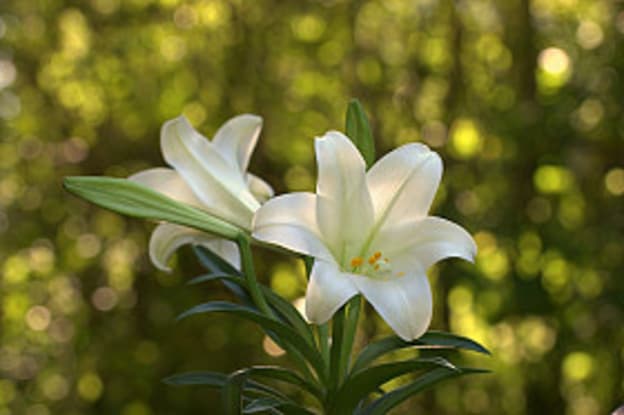In spring, Easter lilies fill our homes with bright blooms and fragrant aromas. While the flowers seem to quickly come and go, there are some guidelines that may extend the life of your lily, as well as a few easy steps to follow if you choose to plant it outdoors.
- Leave the plant indoors until the last frost, usually sometime after April in the Mid-Atlantic region.
- Keep your lily plant(s) in a sunny location, but away from direct sunlight, heat or heavy draughts.
- Easter lilies prefer cooler temperatures, usually around 60-65º during the day and 55-60º during the night. Be sure to water your plant if the surface of the soil feels dry; however, beware of drowning your lily.
- Remove the decorative foil and allow the excess water to drain through the soil into a saucer. Empty the saucer regularly to avoid having the lily sit in water.
- Keep in mind that the Easter lily is highly toxic to cats, so chose a location that will keep your pets out of trouble!
In preparation for planting your lily outdoors, it is good to remove the flower heads as they begin to fade to keep the plant from seeding. This will help conserve the plant's energy for next year's flowers. Once the blooms have faded and all danger of frost has past find a bright, sunny location in your garden to plant your lily.
Once again, appropriate drainage is very important for Easter lilies. Our experts recommend using Southern States Professional Potting Mix, or a blend of one part soil, one part moss, and one part perlite.
Planting Your Easter Lily In Your Garden
- Set the entire pot and plant into the soil until all the foliage has died back.
- Remove the old foliage and carefully place the bulb into the soil, making sure to loosen the root system slightly.
- Plant the bulb in the soil a little deeper than it was in its container, approximately six inches below the soil's surface.
- Spread the roots to make sure there are no air pockets, and cover the bulb with soil and mulch.
- Finally, cut the stems back to the ground and water thoroughly.
- As winter approaches, feed the soil on a monthly basis with a 4-10-6 flower fertilizer such as Espoma Bulb Tone or an all-purpose fertilizer such as Southern States Green Gro 10-10-10.
- Apply a few more inches of mulch for insulation during the winter then remove the mulch as the weather begins to warm again in the spring.
Lilies grown in cooler zones should be dug up in the fall and kept indoors until spring, or planted at least eight inches deep with heavier mulch.
Don't expect to see your lilies again on Easter! If you are lucky, the Easter lilies might produce a second bloom in September; however, most often they wait until the following June or July which is their natural blooming period.



